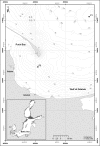Seasonal changes in the abundance and biomass of copepods in the south-eastern Baltic Sea in 2010 and 2011
- PMID: 30210945
- PMCID: PMC6132220
- DOI: 10.7717/peerj.5562
Seasonal changes in the abundance and biomass of copepods in the south-eastern Baltic Sea in 2010 and 2011
Abstract
Background: Copepods are major secondary producers in the World Ocean. They represent an important link between phytoplankton, microzooplankton and higher trophic levels such as fish. They are an important source of food for many fish species but also a significant producer of detritus. In the terms of the role they play in the marine food web, it is important to know how environmental variability affects the population of copepods.
Methods: The study of the zooplankton community in the south-eastern Baltic Sea conducted during a 24-month survey (from January 2010 to November 2011) resulted in the identification of 24 invertebrate species (10 copepods, seven cladocerans, four rotifers, one ctenophore, one larvacean, and one amphipod). Data were collected at two stations located in the open sea waters of the Gulf of Gdansk: the Gdansk Deep (P1) (54°50'N, 19°19'E) and in the western, inner part of the Gulf of Gdansk (P2) (54°32'N, 18°48.2'E). The vertical hauls were carried out with the use of two kinds of plankton nets with a mesh size of 100 µm: a Copenhagen net (in 2010), and a WP-2 net (in 2011).
Results: The paper describes the seasonal changes in the abundance and biomass of copepods, taking into account the main Baltic calanoid copepod taxa (Acartia spp., Temora longicornis and Pseudocalanus sp.). They have usually represented the main component of zooplankton. The average number of copepods at the P1 Station during the study period of 2010 was 3,913 ind m-3(SD 2,572) and their number ranged from 1,184 ind m-3 (in winter) to 6,293 ind m-3(in spring). One year later, the average count of copepods was higher, at 11,723 ind m-3(SD 6,980), and it ranged from 2,351 ind m-3(in winter) to 18,307 ind m-3(in summer). Their average count at P2 Station in 2010 was 29,141 ind m-3, ranging from 3,330 ind m-3(in March) to 67,789 ind m-3(in May). The average count of copepods in 2011 was much lower at 17,883 ind m-3, and it ranged from 1,360 ind m-3 (in April) to 39,559 ind m-3 (in May).
Discussion: The environmental conditions of the pelagic habitat change in terms of both depth and distance from the shore. Although the qualitative (taxonomic) structure of zooplankton is almost identical to that of the coastal waters, the quantitative structure (abundance and biomass) changes quite significantly. The maximum values of zooplankton abundance and biomass were observed in the summer season, both in the Gdansk Deep and in the inner part of the Gulf of Gdansk. Copepods dominated in the composition of zooplankton for almost the entire time of the research duration. Quantitative composition of copepods at the P1 Station differed from the one at P2 Station due to the high abundance of Pseudocalanus sp. which prefers colder, more saline waters.
Keywords: Abundance; Baltic Sea; Biomass; Copepoda; Population dynamics.
Conflict of interest statement
The authors declare there are no competing interests.
Figures













Similar articles
-
Jellyfish and comb jellies in the Baltic Sea: Depth resolved distribution pattern along the salinity gradient of the Baltic Sea during September 2020 - dataset.Data Brief. 2025 Mar 22;60:111511. doi: 10.1016/j.dib.2025.111511. eCollection 2025 Jun. Data Brief. 2025. PMID: 40270840 Free PMC article.
-
Zooplankton biomass, size structure, and associated metabolic fluxes with focus on its roles at the chlorophyll maximum layer during the plankton-contaminant MERITE-HIPPOCAMPE cruise.Mar Pollut Bull. 2023 Aug;193:115056. doi: 10.1016/j.marpolbul.2023.115056. Epub 2023 Jun 21. Mar Pollut Bull. 2023. PMID: 37352804
-
Seasonal and diel variations in the vertical distribution, composition, abundance and biomass of zooplankton in a deep Chilean Patagonian Fjord.PeerJ. 2022 Jan 25;10:e12823. doi: 10.7717/peerj.12823. eCollection 2022. PeerJ. 2022. PMID: 35127292 Free PMC article.
-
Indicator Properties of Baltic Zooplankton for Classification of Environmental Status within Marine Strategy Framework Directive.PLoS One. 2016 Jul 13;11(7):e0158326. doi: 10.1371/journal.pone.0158326. eCollection 2016. PLoS One. 2016. PMID: 27410261 Free PMC article. Review.
-
A synthesis of growth rates in marine epipelagic invertebrate zooplankton.Adv Mar Biol. 2003;44:1-142. doi: 10.1016/s0065-2881(03)44002-9. Adv Mar Biol. 2003. PMID: 12846041 Review.
Cited by
-
Zooplankton impact on lipid biomarkers in water column vs. surface sediments of the stratified Eastern Gotland Basin (Central Baltic Sea).PLoS One. 2020 Jun 12;15(6):e0234110. doi: 10.1371/journal.pone.0234110. eCollection 2020. PLoS One. 2020. PMID: 32530916 Free PMC article.
References
-
- Ackefors A. Biological oceanography. In: Voipio A, editor. The Baltic Sea. Vol. 30. Elsevier; Dordrecht: 1981. pp. 238–255.
-
- Ackefors H, Hernroth L. Djurplankton I Östersjöområdet. Zoologisk Revy. 1972;34:6–31. [in Swedish]
-
- Andrulewicz E, Szymelfenig M, Urbański J, Węsławski JM, Węsławski S. Baltic Sea—it is worth knowing about it. Polish Ecological Club; East Pomeranian District: 2008. p. 115. [in Polish]
-
- Bielecka L, Mudrak-Cegiołka S, Kalarus M. Evadne anonyx G. O. Sars, 1897—the first record of this ponto-Caspian cladoceran in the Gulf of Gdańsk (Baltic Sea) Oceanologia. 2014;56(1):141–150. doi: 10.5697/oc.56-1.141. - DOI
-
- Cyberski J. Contemporary and forecast changes in the water balance and its role in shaping the salinity of the Baltic Sea. University of Gdansk Publishing House; Gdańsk: 1995. (Dissertations and monographs 206). [in Polish]
LinkOut - more resources
Full Text Sources
Other Literature Sources
Miscellaneous

